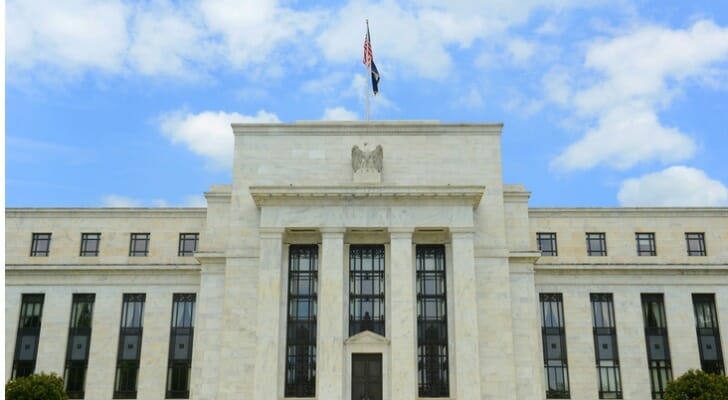 When inflation threatens an economy by becoming excessive, the government has two ways to dial back the problem: Contractionary fiscal policy and contractionary monetary policy. Congress handles the former, while the U.S. central bank, known as the Federal Reserve or Fed, handles the latter. Here is an overview of how these two approaches work.
When inflation threatens an economy by becoming excessive, the government has two ways to dial back the problem: Contractionary fiscal policy and contractionary monetary policy. Congress handles the former, while the U.S. central bank, known as the Federal Reserve or Fed, handles the latter. Here is an overview of how these two approaches work.
Why Excessive Inflation is a Concern
But first, a word about inflation. A moderate level of inflation is widely viewed as a good thing. When an economy grows, workers gain spending power and standards of living tend to rise. The goal of economic growth is to allow everyone to share in prosperity.
However, any economy also has a limited capacity, also known as “productivity,” which is the total amount of goods and services that the economy can produce every year. If purchasing power grows more quickly than productivity, people will soon be able to buy more goods and services than the economy can produce. This leads to inflation.
As inflation spirals, basic products get more expensive, making them harder to buy and eroding standards of living. In other words, what was helpful in small doses becomes unhelpful in larger doses.
Contractionary Fiscal Policy
If Congress wanted to pursue a contractionary fiscal policy to slow down an overly heated economy, it could do so in a couple of ways. One way would be to raise taxes – both direct taxes and indirect taxes. A direct tax is a tax that is paid straight from the individual or business to the government body imposing the tax. Examples of direct taxes include personal income taxes (federal and state) and corporate income taxes.
Indirect taxes, by contrast, do not flow straight from the payer to the government. For example, when you pay a sales tax you don’t actually pay that money to the government. The merchant who sells you some goods or provides you a service pays the sales tax to the government. Indirect taxes are by definition taxes that are in some sense hidden. You pay a higher price for a flat-screen TV to account for the sales tax rather than writing the government a check for that sales tax amount.
Whether direct or indirect, taxes pull money out of the economy and as a result slow business activity. Another way Congress could pursue a contractionary policy would be to cut spending. It could cut back on the appropriations of goods and services as well as on hiring. The aim of this approach would be to slow the rate at which the economy is growing.
However, it is not very common for lawmakers, who depend on pleasing an electorate, to dial back the amount of money they are spending on constituents. Voters tend to support politicians who promise them more, not less.
Contractionary Monetary Policy

A much more common approach to cooling off an excessively inflationary economy is by monetary policy. One way the Federal Reserve could do this is to raise interest rates to make borrowing money more expensive. When rates rise, both consumers and businesses borrow less money. When businesses aren’t focused on expanding, they’re less likely to hire employees or develop products or expand their operations.
On the consumer side, this can lead to a drop in demand for goods and services. To keep consumers’ spending, businesses can adjust their pricing downward. In this way, the Fed’s raising interest rates can reduce inflation.
Another way the Federal Reserve can pursue a contractionary monetary policy is by selling Treasurys to other banks. This means that the banks purchasing Treasurys now have less cash in reserve and, thus, less money to lend. They can compensate by raising interest rates, either in accordance with or independently of a Federal Reserve rate hike. But banks raising interest rates has the same effect: when borrowing gets more expensive, fewer people and businesses do it.
A third way the Fed can tamp down an economy is by raising reserve requirements across the banking system. This simply means increasing the minimum amount of money banks are required to keep on hand, thereby reducing the amount of money available for lending.
Effects of Contractionary Policies
 Besides slowing inflation, contractionary policies can have other effects. When inflation drops, prices begin to stabilize and spending becomes less burdensome for the everyday person since purchasing power increases. In other words, your money becomes worth more in a contractionary environment.
Besides slowing inflation, contractionary policies can have other effects. When inflation drops, prices begin to stabilize and spending becomes less burdensome for the everyday person since purchasing power increases. In other words, your money becomes worth more in a contractionary environment.
Secondly, for those with a high marginal propensity to consume – that is, the poor – it becomes more difficult to buy things or carry a balance on your credit cards.
Thirdly, unemployment may rise. If demand for goods and services falls, businesses may reduce staffing to compensate for a drop in revenue. If you work in an industry that’s more likely to feel the blow of contractionary policy, that could mean a higher risk of losing your job due to company cutbacks.
The Bottom Line
Contractionary fiscal and monetary policies can be proactive or reactive, depending on when they are implemented. The overall idea is to slow economic growth when it becomes dangerously excessive or about to become dangerously excessive. Rising interest rates, increasing unemployment or higher taxes can all be earmarks of a contractionary monetary policy in action.
Tips for Investing Under Contractionary Policies
- A financial advisor can help you understand how economic trends and government policy can impact your investments. Finding a financial advisor doesn’t have to be hard. SmartAsset’s free tool matches you with up to three vetted financial advisors who serve your area, and you can interview your advisor matches at no cost to decide which one is right for you. If you’re ready to find an advisor who can help you achieve your financial goals, get started now.
- A number of economic indicators react to monetary policy and can help you determine how to protect your investments. If you aren’t keeping an eye on the GDP, consumer price index or unemployment numbers, you may want to start.
Photo credit: ©iStock.com/agrobacter, ©iStock.com/jiawangkun, ©iStock.com/spukkato